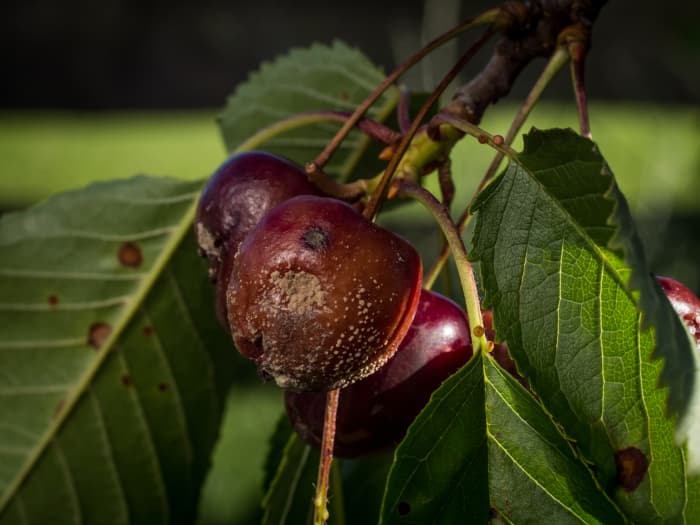Cherry trees are susceptible to several diseases that can damage their appearance and health. Being able to identify these diseases is crucial for properly caring for your cherry tree. Here are 10 pictures of the most common cherry tree diseases along with information on their symptoms causes, and treatment.
1. Black Knot
![Black knot disease on a cherry tree branch][]
Black knot causes rough black swellings on branches. These knots enlarge over time and may ooze in wet weather. It’s caused by the fungus Apiosporina morbosa and spreads via spores. Prune out infected branches.
2. Brown Rot![Cherry fruit with brown rot infection][]
Brown rot causes blossoms and fruit to turn brown or grayish-brown. A white fuzzy growth may appear on infected areas. It’s caused by the Monilinia fungus and spreads in wet weather. Remove diseased fruit and prune infected branches.
3. Cherry Leaf Spot![Cherry tree leaf with purple leaf spot lesions][]
Purple or brown spots develop on leaves and enlarge over time. Older leaves may turn yellow and fall off. It’s caused by the fungus Blumeriella jaapii and spreads via spores. Rake up and dispose of fallen leaves to remove the source of reinfection.
4. Powdery Mildew![Cherry leaves covered in white powdery mildew][]
A white or gray powdery fungus grows on leaves, shoots, and fruit. Leaves may become distorted or drop early. It’s caused by the fungus Podosphaera clandestina and spreads via windborne spores. Improve air circulation through pruning and avoid overcrowding.
5. Silver Leaf![Cherry tree leaves with silver discoloration from silver leaf disease][]
Leaves develop a silvery sheen. Dead spots may also appear. Branch dieback and fungal fruiting bodies may occur on bark. It’s caused by the fungus Chondrostereum purpureum. Prune out infected branches well below affected areas.
6. Bacterial Canker![Cherry tree canker oozing reddish sap][]
Sunken or cracked cankers form on branches and trunk. Reddish sap may ooze from cankers. It’s caused by the bacterium Pseudomonas syringae. Prune out infected areas, sterilizing tools between cuts. Avoid excessive pruning that leaves wounds.
7. Phytophthora Root Rot![Cherry tree infected with Phytophthora root rot][]
Leaves wilt, turn yellow, and drop. Roots turn brown and the tree declines. It’s caused by Phytophthora fungus in wet soil. Improve drainage and avoid overwatering. Fungicides may help prevent infection. Remove severely infected trees.
8. Armillaria Root Rot![Armillaria mushrooms at base of infected cherry tree][]
Leaves yellow, branches die back. Clusters of honey mushrooms may grow on bark. It’s caused by Armillaria fungus in the soil. Remove and destroy infected roots. Improve soil drainage. Fungicides injected into soil may help.
9. Crown Gall![Cherry tree crown gall][]
Rough, round galls or tumors develop on trunk and branches. Caused by Agrobacterium bacteria entering through wounds. Cut out galls or remove entire infected plant. Sterilize tools and avoid wounding.
10. Peach Tree Borer ![Peach tree borer larvae in cherry tree trunk][]
Larvae bore into trunks, causing sap flow, frass, and damage. Adults are clearwing moths. Monitor for injury sites. Use insecticides orintroduce predators. Keep trees healthy to withstand damage. Insert wire in holes to kill larvae.
Spotting signs of disease early allows you to take action before major damage occurs. If you notice any of these cherry tree diseases, consulting an arborist can help diagnose the issue and recommend appropriate treatment. With vigilance and care, your cherry tree can thrive for many years to come.
10 Common Cherry Tree Diseases
What are the common cherry tree diseases?
The common cherry tree diseases have recognizable symptoms. Read on to learn more about cherry tree problems and the best methods of treating diseases of cherry trees. Common cherry tree problems include rot, spot, and knot diseases. Trees can also get blight, canker, and powdery mildew.
How do you know if a cherry tree has a disease?
Informational table showing disease name, symptoms, pathogen/cause, and management of Cherry diseases. Dark-brown to black, hard swellings form on twigs and branches. At first these galls are small but continue to enlarge each year, becoming very rough. Each spring, galls are covered with dark, olive-green, felt-like growth.
What happens if a cherry tree is infected?
If cherry fruit is infected, it develops reddish bumps. Prune away all diseased parts of the tree. This disease can often be prevented by taking care not to let irrigation water touch the tree leaves. For severe infections, apply copper spray at 50 percent leaf drop.
Can cherry trees die from leaf spot disease?
All trees from the cherry family are vulnerable to leaf spot disease. This affects the leaves, creating brown spots that can cover the entire leaf in an advanced stage, causing its death. Severe cases lead to the end of the tree eventually. The only treatment is to remove the affected leaves to prevent the disease from spreading.

